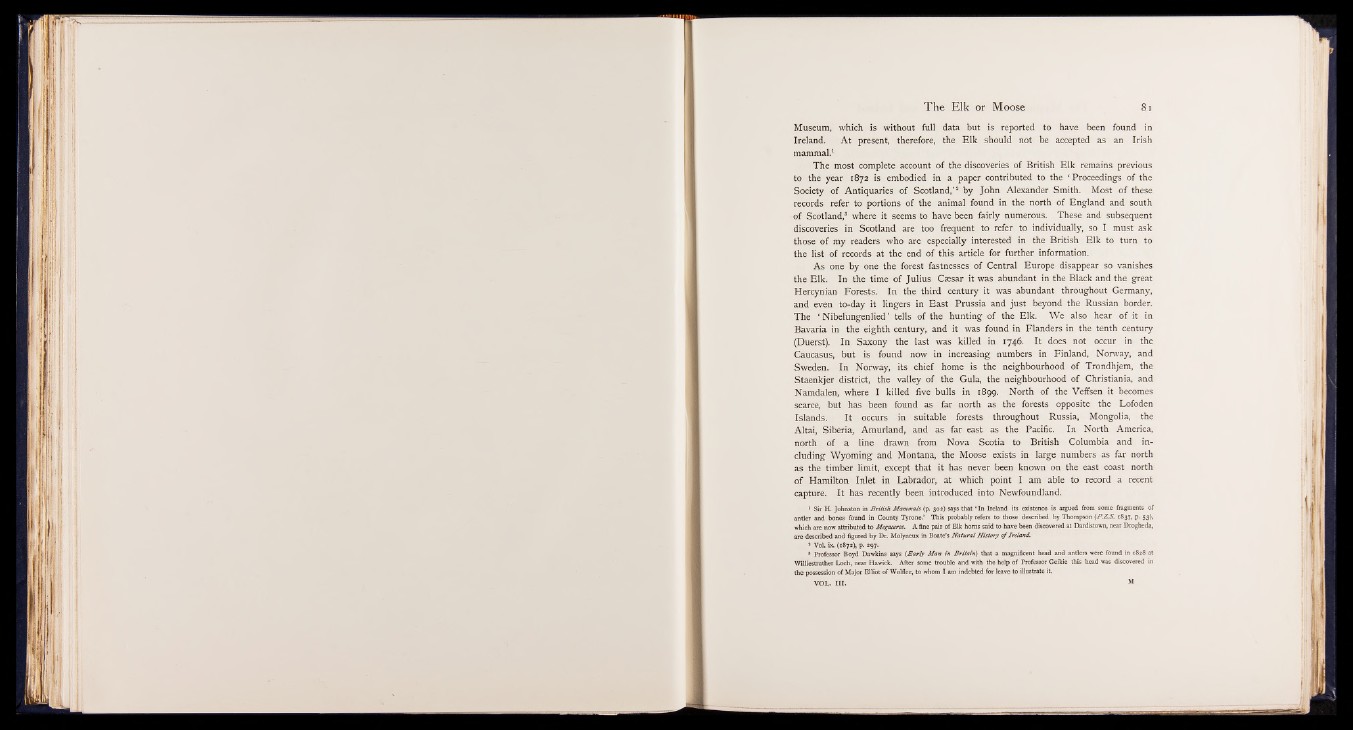
Museum, which is without full data but is reported to have been found in
Ireland. At present, therefore, the Elk should not be accepted as an Irish
mammal.1
The most complete account of the discoveries of British Elk remains previous
to thé year 1872 is embodied in a paper contributed to the ‘ Proceedings of the
Society of Antiquaries of Scotland,’ 2 by John Alexander Smith. Most of these
records refer to portions of the animal found in the north of England and south
of Scotland,® where it seems to have been fairly numerous. These and subsequent
discoveries in Scotland are too frequent to refer to individually, so I must ask
those of my readers who are especially interested in the British Elk to turn to
the list of records at the end of this article for further information.
As one by one the forest fastnesses of Central Europe disappear so vanishes
the Elk. In the time of Julius Caesar it was abundant in the Black and the great
Hercynian Forests. In the third century it was abundant throughout Germany,
and even to-day it lingers in East Prussia and just beyond the Russian border.
The ‘ Nibelungenlied ’ tells of the hunting of the Elk. We also hear of it in
Bavaria in the eighth century, and it was found in Flanders in the tenth century
(Duerst). In Saxony the last was killed in 1746. It does not occur in the
Caucasus, but is found now in increasing numbers in Finland, Norway, and
Sweden. In Norway, its chief home is the neighbourhood of Trondhjem, the
Staenkjer district, the valley of the Gula, the neighbourhood of Christiania, and
Namdalen, where I killed five bulls in 1899. North of the Veffsen it becomes
scarce, but has been found as far north as the forests opposite the Lofoden
Islands. It occurs in suitable forests throughout Russia, Mongolia, the
Altai, Siberia, Amurland, and as far east as the Pacific. In North America,
north of a line drawn from Nova Scotia to British Columbia and including
Wyoming and Montana, the Moose exists in large numbers as far north
as the timber limit, except that it has never been known on the east coast north
of Hamilton Inlet in Labrador, at which point I am able to record a recent
capture. It has recently been introduced into Newfoundland.
1 Sir H. Johnston in B ritish Mammals (p. 302) says that ‘ In Ireland its existence is argued from some fragments of
antler and bones found in County Tyrone.’ This probably refers to those described by Thompson (P .Z S . 1837, p. 53),
which are now attributed to Megaceros. A fine pair o f Elk horns said to have been discovered at Dardistown, near Drogheda,
are described and figured by Dr. Molyneux in Boate’s Natural History o f Ireland.
* Vol. ix. (1872), p. 297.
* Professor Boyd Dawkins says (Early Man in Britain) that a magnificent head and antlers were found in 1828 at
Williestruther Loch, near Hawick. After some trouble and with the help o f Professor Geikie this head was discovered in
the possession of Major Elliot o f Wolflee, to whom I am indebted for leave to illustrate it
VOL. III . M